2022 TOYOTA SIENNA HYBRID check engine light
[x] Cancel search: check engine lightPage 4 of 600
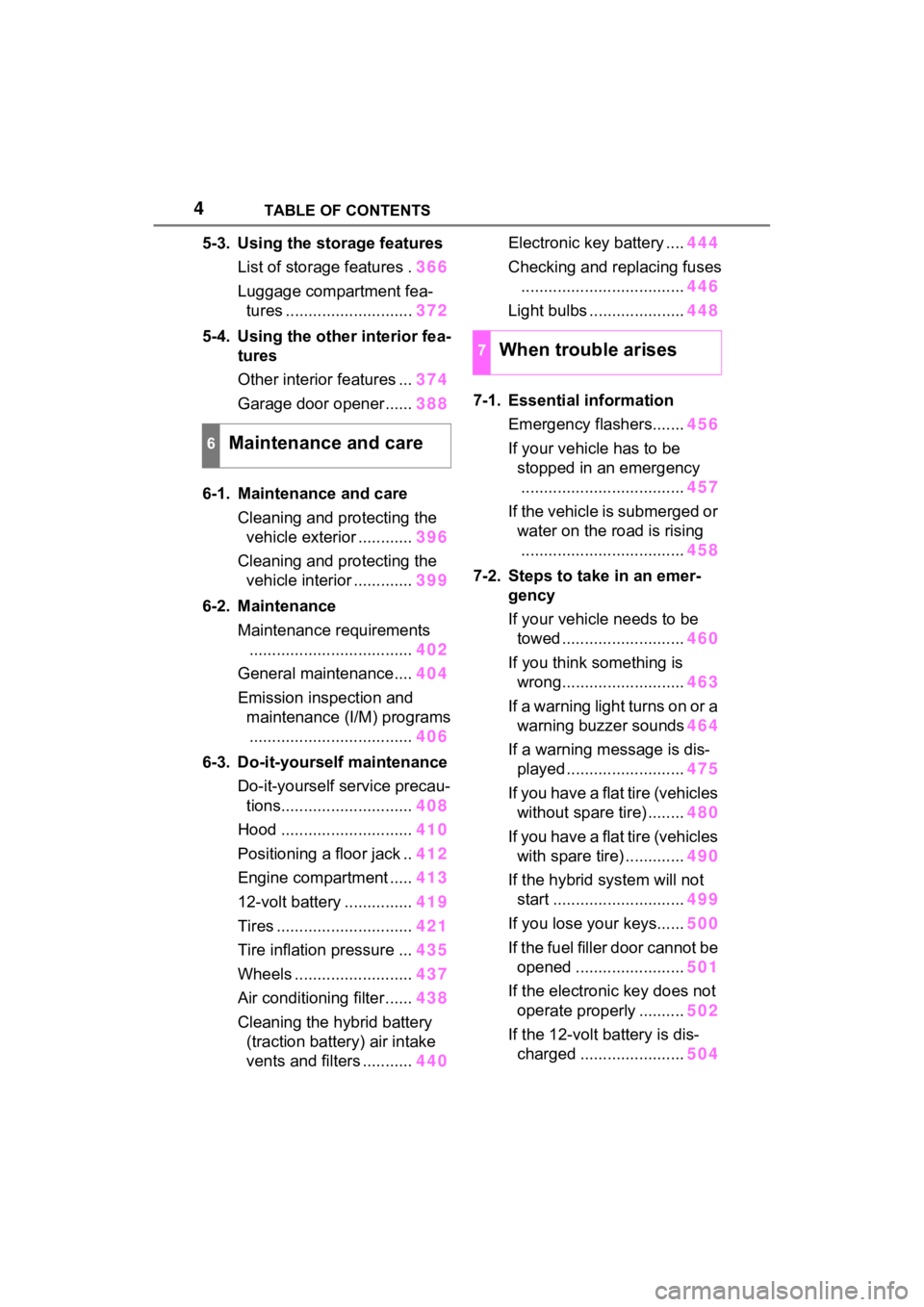
4TABLE OF CONTENTS
5-3. Using the storage featuresList of storage features . 366
Luggage compartment fea- tures ............................ 372
5-4. Using the other interior fea- tures
Other interior features ... 374
Garage door opener...... 388
6-1. Maintenance and care Cleaning and protecting the vehicle exterior ............ 396
Cleaning and protecting the vehicle interior ............. 399
6-2. Maintenance Maintenance requirements.................................... 402
General maintenance.... 404
Emission inspection and maintenance (I/M) programs.................................... 406
6-3. Do-it-yourself maintenance Do-it-yourself service precau-tions............................. 408
Hood ............................. 410
Positioning a floor jack .. 412
Engine compartment ..... 413
12-volt battery ............... 419
Tires .............................. 421
Tire inflation pressure ... 435
Wheels ......... .................437
Air conditioning filter ...... 438
Cleaning the hybrid battery (traction battery) air intake
vents and filters ........... 440Electronic key battery ....
444
Checking and replacing fuses .................................... 446
Light bulbs ..................... 448
7-1. Essential information Emergency flashers....... 456
If your vehicle has to be stopped in an emergency.................................... 457
If the vehicle is submerged or water on the road is rising.................................... 458
7-2. Steps to take in an emer- gency
If your vehicle needs to be towed ........................... 460
If you think something is wrong........................... 463
If a warning light turns on or a warning buzzer sounds 464
If a warning message is dis- played .......................... 475
If you have a flat tire (vehicles without spare tire) ........ 480
If you have a flat tire (vehicles with spare tire) ............. 490
If the hybrid system will not start ............................. 499
If you lose your keys...... 500
If the fuel filler door cannot be opened ......... ...............501
If the electronic key does not oper ate prop erly
..........502
If the 12-volt battery is dis- charged ....................... 504
6Maintenance and care
7When trouble arises
Page 15 of 600
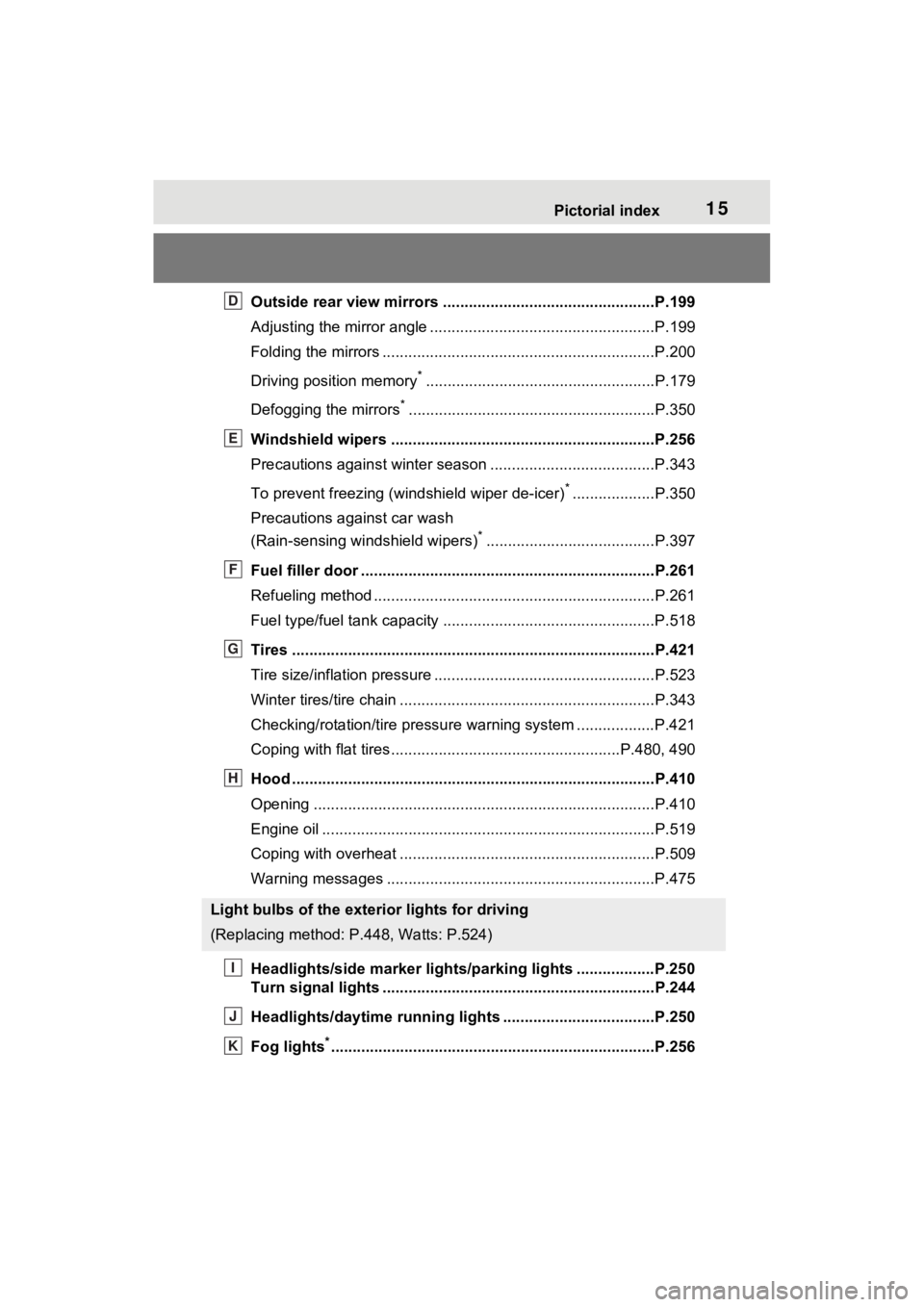
15Pictorial index
Outside rear view mirrors .................................................P.199
Adjusting the mirror angle ....................................................P.199
Folding the mirrors ...............................................................P.200
Driving position memory
*.....................................................P.179
Defogging the mirrors
*.........................................................P.350
Windshield wipers .............................................. ...............P.256
Precautions against winter season .............................. ........P.343
To prevent freezing (windshield wiper de-icer)
*...................P.350
Precautions against car wash
(Rain-sensing windshield wipers)
*.......................................P.397
Fuel filler door ............................................... .....................P.261
Refueling method ............................................... ..................P.261
Fuel type/fuel tan k capacity .................................................P.518
Tires ....................................................................................P.421
Tire size/inflation pressure ................................... ................P.523
Winter tires/tire chain ........................................ ...................P.343
Checking/rotation/tire pressur e warning system ..................P.421
Coping with flat tires......................................... ............P.480, 490
Hood ....................................................................................P.410
Opening ........................................................ .......................P.410
Engine oil ..................................................... ........................P.519
Coping with overheat ........................................... ................P.509
Warning messages ..............................................................P.475
Headlights/side marke r lights/parking lights ..................P.250
Turn signal lights ...............................................................P.244
Headlights/daytime running lights .............................. .....P.250
Fog lights
*............................................................... ............P.256
Light bulbs of the exterior lights for driving
(Replacing method: P.448, Watts: P.524)
D
E
F
G
H
I
J
K
Page 214 of 600
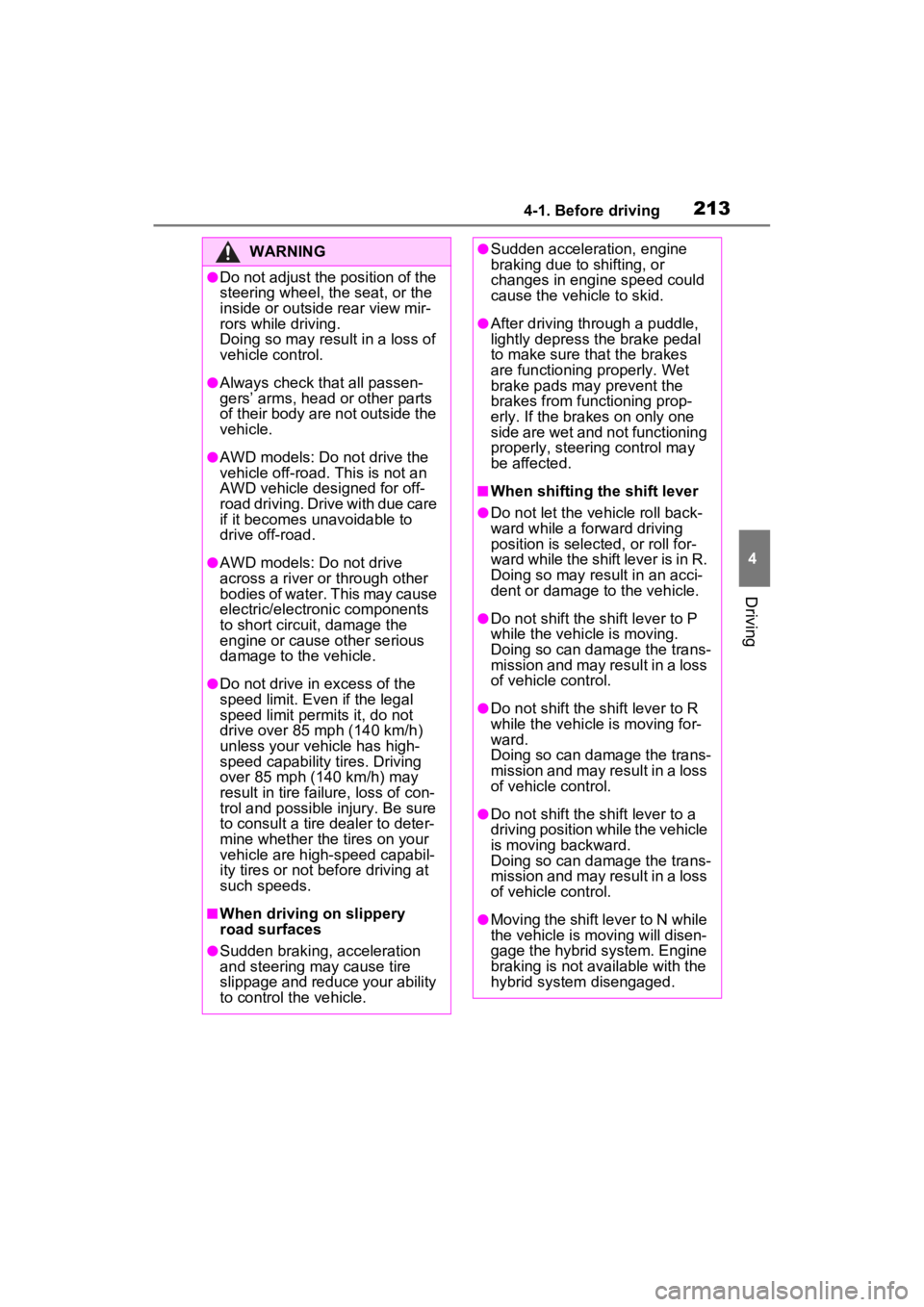
2134-1. Before driving
4
Driving
WARNING
●Do not adjust the position of the
steering wheel, the seat, or the
inside or outside rear view mir-
rors while driving.
Doing so may result in a loss of
vehicle control.
●Always check that all passen-
gers’ arms, head or other parts
of their body are not outside the
vehicle.
●AWD models: Do not drive the
vehicle off-road. This is not an
AWD vehicle designed for off-
road driving. Drive with due care
if it becomes unavoidable to
drive off-road.
●AWD models: Do not drive
across a river or through other
bodies of water. This may cause
electric/electronic components
to short circuit, damage the
engine or cause other serious
damage to the vehicle.
●Do not drive in excess of the
speed limit. Even if the legal
speed limit permits it, do not
drive over 85 mph (140 km/h)
unless your vehicle has high-
speed capability tires. Driving
over 85 mph (140 km/h) may
result in tire failure, loss of con-
trol and possible injury. Be sure
to consult a tire dealer to deter-
mine whether the tires on your
vehicle are high-speed capabil-
ity tires or not b efore driving at
such speeds.
■When driving on slippery
road surfaces
●Sudden braking, acceleration
and steering may cause tire
slippage and reduce your ability
to control the vehicle.
●Sudden acceleration, engine
braking due to shifting, or
changes in engine speed could
cause the vehicle to skid.
●After driving through a puddle,
lightly depress the brake pedal
to make sure that the brakes
are functioning properly. Wet
brake pads may prevent the
brakes from functioning prop-
erly. If the brakes on only one
side are wet and not functioning
properly, steering control may
be affected.
■When shifting the shift lever
●Do not let the vehicle roll back-
ward while a fo rward driving
position is selected, or roll for-
ward while the shift lever is in R.
Doing so may result in an acci-
dent or damage to the vehicle.
●Do not shift the shift lever to P
while the vehicle is moving.
Doing so can damage the trans-
mission and may result in a loss
of vehicle control.
●Do not shift the sh ift lever to R
while the vehicle is moving for-
ward.
Doing so can damage the trans-
mission and may result in a loss
of vehicle control.
●Do not shift the shift lever to a
driving position while the vehicle
is moving backward.
Doing so can damage the trans-
mission and may result in a loss
of vehicle control.
●Moving the shift lever to N while
the vehicle is moving will disen-
gage the hybrid system. Engine
braking is not a vailable with the
hybrid system disengaged.
Page 215 of 600
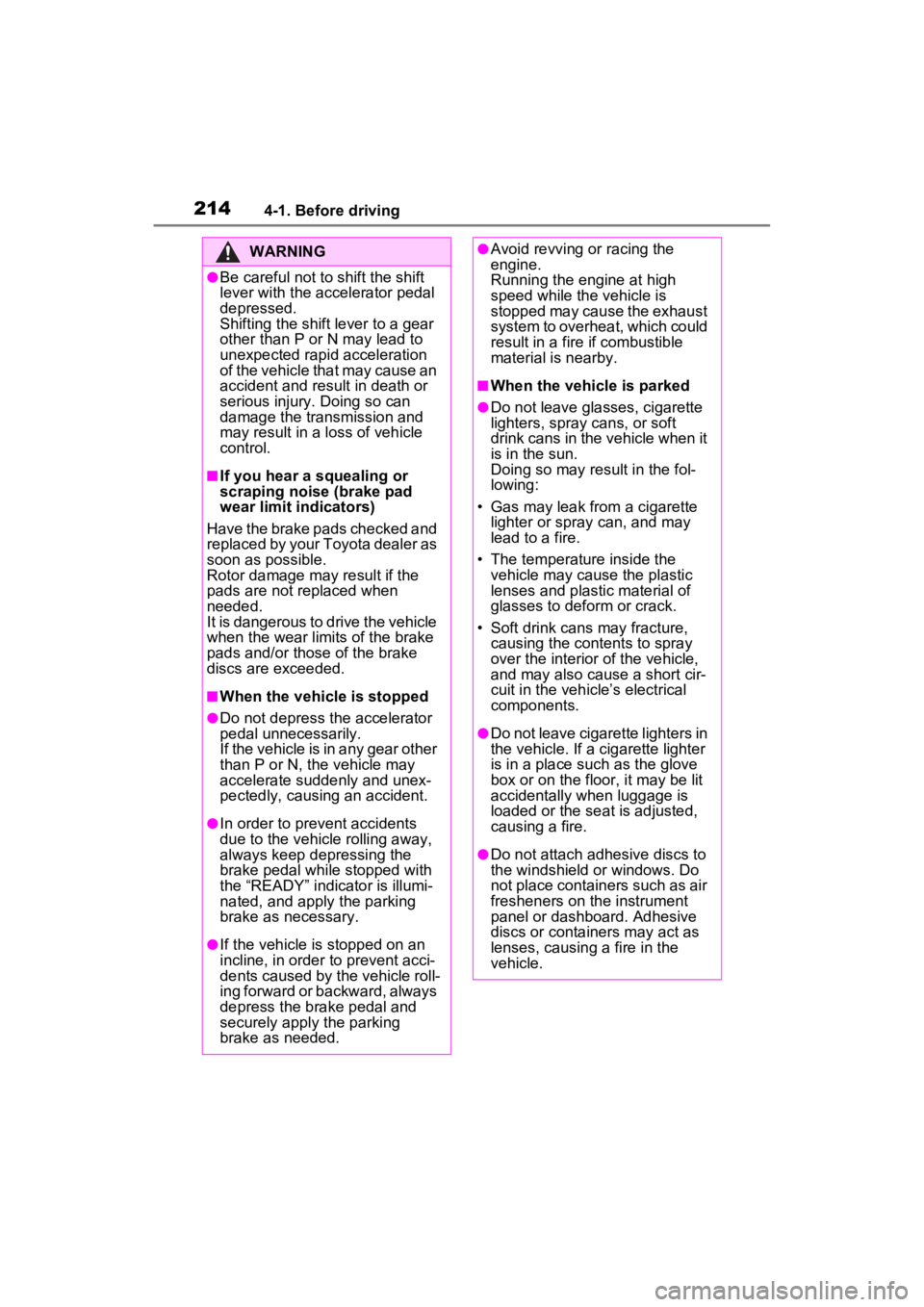
2144-1. Before driving
WARNING
●Be careful not to shift the shift
lever with the accelerator pedal
depressed.
Shifting the shift lever to a gear
other than P or N may lead to
unexpected rapid acceleration
of the vehicle that may cause an
accident and result in death or
serious injury. Doing so can
damage the transmission and
may result in a loss of vehicle
control.
■If you hear a squealing or
scraping noise (brake pad
wear limit indicators)
Have the brake pads checked and
replaced by your Toyota dealer as
soon as possible.
Rotor damage may result if the
pads are not replaced when
needed.
It is dangerous to drive the vehicle
when the wear limits of the brake
pads and/or those of the brake
discs are exceeded.
■When the vehicle is stopped
●Do not depress t he accelerator
pedal unnecessarily.
If the vehicle is in any gear other
than P or N, the vehicle may
accelerate suddenly and unex-
pectedly, causing an accident.
●In order to prev ent accidents
due to the vehicle rolling away,
always keep depressing the
brake pedal while stopped with
the “READY” indicator is illumi-
nated, and apply the parking
brake as necessary.
●If the vehicle is stopped on an
incline, in order to prevent acci-
dents caused by the vehicle roll-
ing forward or backward, always
depress the brake pedal and
securely apply the parking
brake as needed.
●Avoid revving or racing the
engine.
Running the engine at high
speed while the vehicle is
stopped may cause the exhaust
system to overheat, which could
result in a fire if combustible
material is nearby.
■When the vehicle is parked
●Do not leave glasses, cigarette
lighters, spray cans, or soft
drink cans in the vehicle when it
is in the sun.
Doing so may result in the fol-
lowing:
• Gas may leak from a cigarette lighter or spray can, and may
lead to a fire.
• The temperature inside the vehicle may cause the plastic
lenses and plastic material of
glasses to deform or crack.
• Soft drink cans may fracture, causing the contents to spray
over the interior of the vehicle,
and may also cause a short cir-
cuit in the vehicle’s electrical
components.
●Do not leave cigarette lighters in
the vehicle. If a cigarette lighter
is in a place such as the glove
box or on the floor, it may be lit
accidentally when luggage is
loaded or the se at is adjusted,
causing a fire.
●Do not attach adhesive discs to
the windshield or windows. Do
not place containers such as air
fresheners on the instrument
panel or dashboard. Adhesive
discs or containers may act as
lenses, causing a fire in the
vehicle.
Page 342 of 600
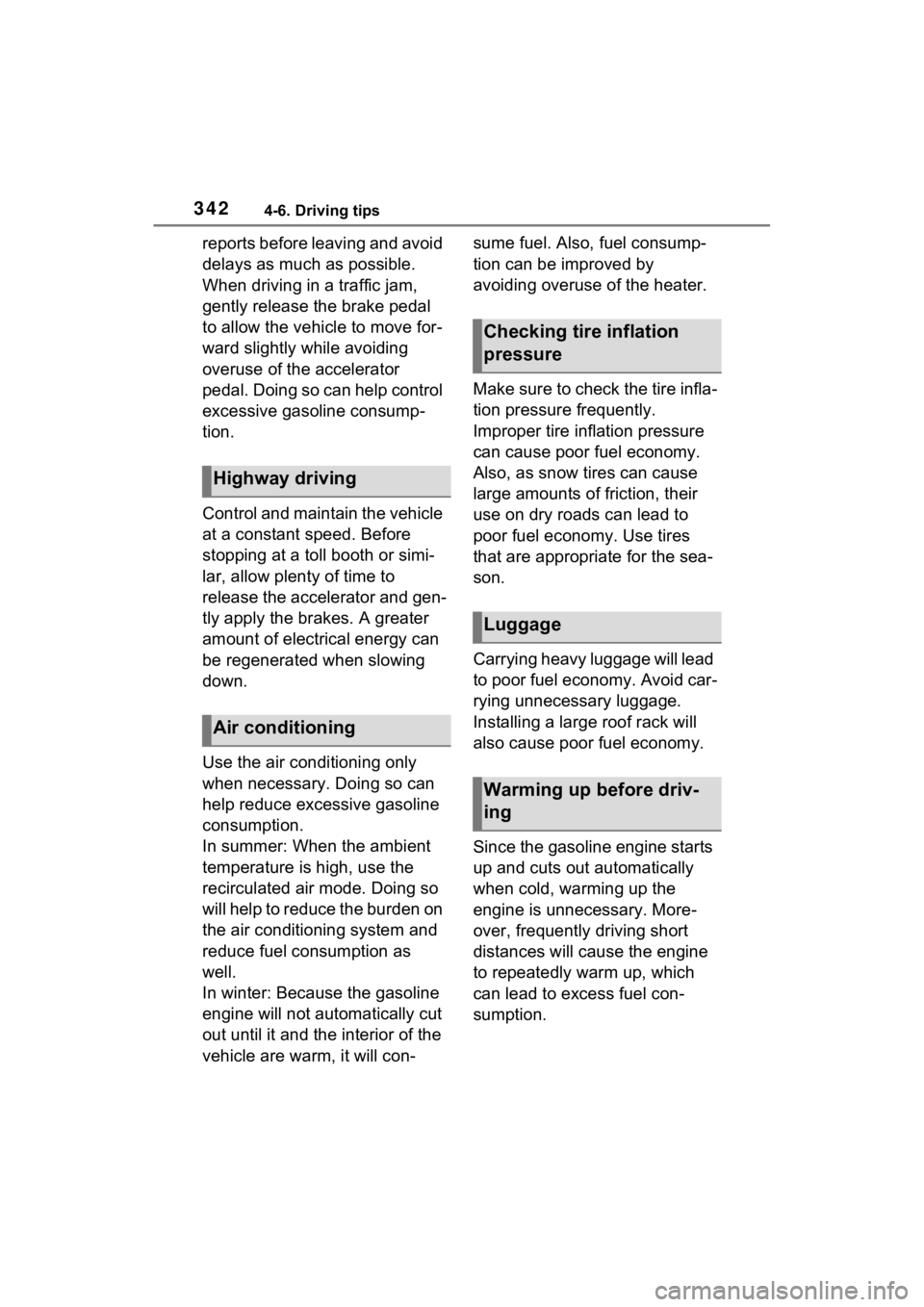
3424-6. Driving tips
reports before leaving and avoid
delays as much as possible.
When driving in a traffic jam,
gently release the brake pedal
to allow the vehicle to move for-
ward slightly while avoiding
overuse of the accelerator
pedal. Doing so can help control
excessive gasoline consump-
tion.
Control and maintain the vehicle
at a constant speed. Before
stopping at a toll booth or simi-
lar, allow plenty of time to
release the accelerator and gen-
tly apply the brakes. A greater
amount of electrical energy can
be regenerated when slowing
down.
Use the air conditioning only
when necessary. Doing so can
help reduce excessive gasoline
consumption.
In summer: When the ambient
temperature is high, use the
recirculated air mode. Doing so
will help to reduce the burden on
the air conditioning system and
reduce fuel consumption as
well.
In winter: Because the gasoline
engine will not automatically cut
out until it and the interior of the
vehicle are warm, it will con-sume fuel. Also, fuel consump-
tion can be improved by
avoiding overuse of the heater.
Make sure to check the tire infla-
tion pressure frequently.
Improper tire inflation pressure
can cause poor fuel economy.
Also, as snow tires can cause
large amounts of friction, their
use on dry roads can lead to
poor fuel economy. Use tires
that are appropriate for the sea-
son.
Carrying heavy luggage will lead
to poor fuel economy. Avoid car-
rying unnecessary luggage.
Installing a large roof rack will
also cause poor fuel economy.
Since the gasoline engine starts
up and cuts out automatically
when cold, warming up the
engine is unnecessary. More-
over, frequently driving short
distances will cause the engine
to repeatedly warm up, which
can lead to excess fuel con-
sumption.
Highway driving
Air conditioning
Checking tire inflation
pressure
Luggage
Warming up before driv-
ing
Page 395 of 600
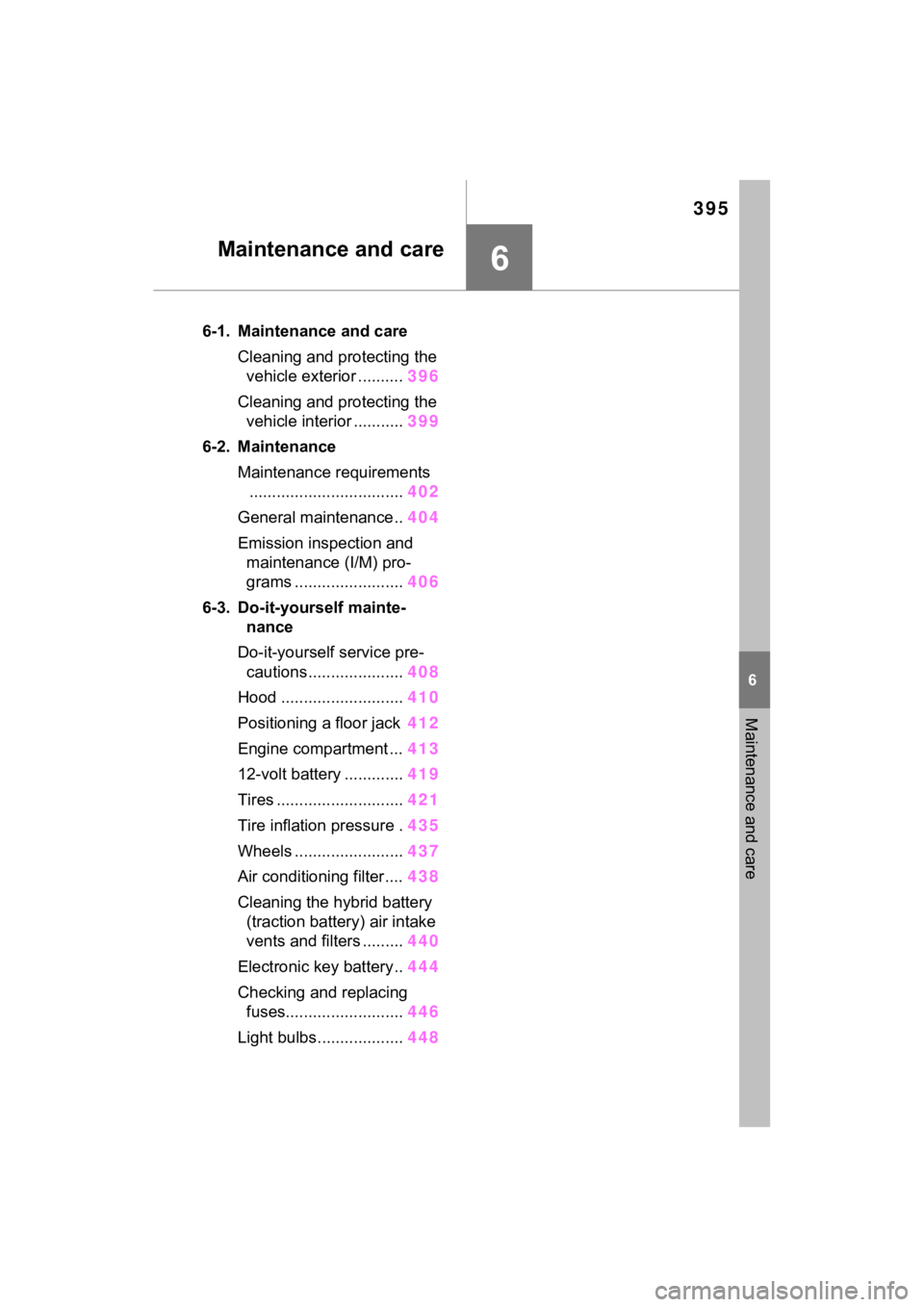
395
6
6
Maintenance and care
Maintenance and care
6-1. Maintenance and careCleaning and protecting the vehicle exterior .......... 396
Cleaning and protecting the vehicle interior ........... 399
6-2. Maintenance Maintenance requirements.................................. 402
General maintenance.. 404
Emission inspection and maintenance (I/M) pro-
grams ........................ 406
6-3. Do-it-yourself mainte- nance
Do-it-yourself service pre- cautions ..................... 408
Hood ........................... 410
Positioning a floor jack 412
Engine compartment ... 413
12-volt battery ............. 419
Tires ............................ 421
Tire inflation pressure . 435
Wheels ......... ...............437
Air conditioning filter .... 438
Cleaning the hybrid battery (traction battery) air intake
vents and filters ......... 440
Electronic key battery.. 444
Checking and replacing fuses.......................... 446
Light bulbs................... 448
Page 572 of 600

572Alphabetical Index
Power easy access system .. 179
Driving support system informa- tion display ........................... 110
Dynamic radar cruise control with full-speed rangeFunction ............................... 290
Warning message ................ 475
E
ECB (Electronically Controlled Brake System) ...................... 334
Eco drive mode ...................... 333
EDR (Event data recorder)......... 8
E-Four (Electronic On-Demand AWD system) ........................ 335
Elapsed time ........................... 111
Electric motor Location.................................. 79
Specification ......................... 518
Electric Power Steering (EPS) Function ............................... 335
Warning light ........................ 466
Electronically Controlled Brake System (ECB) ....................... 334
Electronic key Battery-saving function......... 166
If the electronic key does not operate properly ................. 502
Replacing the battery ........... 444
Emergency, in case of If a warning buzzer sounds .. 464
If a warning light turns on ..... 464
If a warning message is dis-played................................. 475
If the 12-volt battery is dis- charged .............................. 504
If the electronic key does not operate properly ................. 502
If the fuel filler door cannot be opened ............................... 501
If the hybrid sy stem will not start
........................................... 499 If the vehicle is submerged or
water on the road is rising ..458
If you have a flat tire .....480, 490
If you lose your keys.............500
If you think something is wrong ...........................................463
If your vehicle becomes stuck ...........................................513
If your vehicle has to be stopped in an emergency .................457
If your vehicle needs to be towed ...........................................460
If your vehicle ove rheats ......509
Emergency flashers ...............456
Energy monitor .......................122
Engine Compartment........................413
Hood .....................................410
Identification number ............518
Engine coolant Capacity ...............................520
Checking ..............................416
Preparing and checking before winter ..................................343
Warning light ........................465
Engine coolant temperature gauge ...............................97, 101
Engine oil Capacity ...............................519
Checking ..............................413
Preparing and checking before winter ..................................343
Warning light ........................465
Engine oil maintenance data .415
Enhanced Vehicle Stability Con- trol (Enhanced VSC ) .............335
Enhanced VSC (Enhanced Vehi- cle Stability Control).............335
EPS (Electric Po wer Steering)
Function................................335
Warning light ........................466
EV drive mode.........................238
Page 582 of 600

582Alphabetical Index
........................................... 302
RCTA OFF indicator............. 468
Seat belt reminder ................ 471
Vehicle sway warning........... 281
Warning lights ABS ...................................... 466
Brake hold operated indicator........................................... 469
Brake Override System ........ 469
Brake system ....................... 464
Charging system .................. 464
Drive-Start Control ............... 469
Electric power steering ......... 466
Engine .................................. 465
High coolant temperature ..... 465
Hybrid system overheat ....... 465
Intuitive parking assist OFF indi- cator ................................... 467
Low engine oil pressure ....... 465
Low fuel level ....................... 470
LTA indicator ........................ 467
Malfunction indicator lamp ... 465
Parking brake indicator ........ 470
PCS warning light................. 467
PKSB (Parking Support Brake) ........................................... 469
PKSB OFF indicato r ............. 468
RCD OFF indicator............... 468
RCTA OFF indicator............. 468
Seat belt reminder light ........ 471
Slip indicator......................... 469
SRS ...................................... 466
Tire pressure ........................ 470
Warning messages ................ 475
Washer Checking .............................. 418
Low washer fluid warning mes-sage ........................... 418, 475
Preparing and c hecking before
winter.................................. 343
Switch........................... 256, 259
Washing and waxing .............. 396 Weights
Cargo capacity .............217, 220
Load limits ............................220
Wheels .....................................437 Replacing wheels .................437
Size ......................................523
Window glasses Power windows ....................202
Window lock switch ...............204
Windows Power windows ....................202
Rear window defogger .........350
Washer .........................256, 259
Windshield defogge r ..............349
Windshield wiper d e-icer .......353
Windshield wipers Intermittent windshield wipers...........................................256
Position.........................256, 259
Rain-sensing windshield wipers ...........................................256
Winter driving tips ..................343
Wireless charger.....................381
Wireless remote control.........130 Battery-saving function .........166
Locking/Unlocking ................130
Panic mode ..........................130
Replacing the battery ...........444
For vehicles with Entune Audio, Entune Audio Plus
or Entune Premium Audio,
refer to the “NAVIGA-
TION AND MULTIMEDIA
SYSTEM OWNER’S MAN-
UAL” for information
regarding the equipment
listed below.
· Navigation system